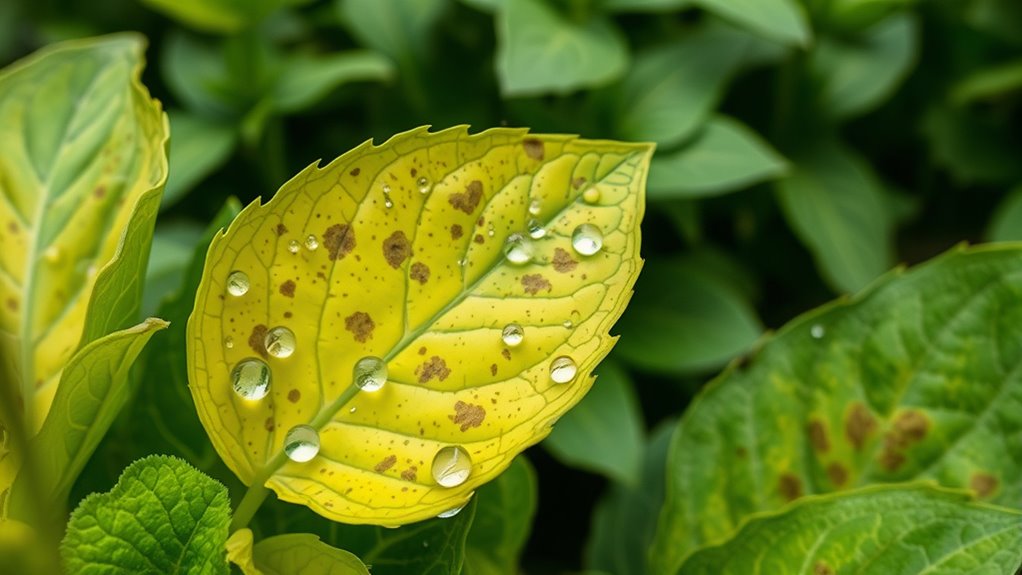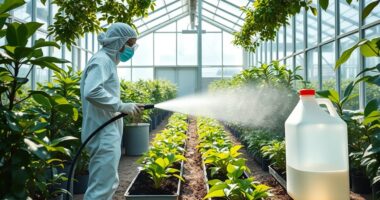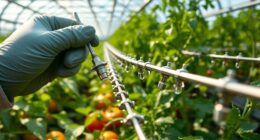Viruses and bacteria can spread quickly in your greenhouse, often infecting plants silently before showing obvious symptoms. They’re easily transmitted via pests, contaminated tools, or reused soil, making prevention essential. Regularly inspect plants, practice good hygiene, and sterilize soil and equipment to reduce risks. Managing pests and maintaining a clean environment help prevent infections. For effective control and to protect your crops, understanding these threats better will give you the insight you need to keep plants healthy.
Key Takeaways
- Viruses and bacteria can spread silently via pests and contaminated soil, causing significant crop damage before symptoms appear.
- Soil sterilization before planting reduces the risk of introducing bacterial or viral pathogens from reused soil or compost.
- Pests like aphids and whiteflies act as vectors, transmitting viruses between plants; effective pest management is crucial.
- Maintaining hygiene through tool disinfection, removing infected plants, and proper watering prevents disease spread.
- Early detection of symptoms and combining soil sterilization, pest control, and hygiene practices are essential for disease management.

Greenhouse plant diseases can quickly threaten your crops if you’re not vigilant. Viruses and bacteria are particularly sneaky because they often spread silently, causing damage that’s hard to detect until it’s too late. To protect your plants, you need to understand how these pathogens operate and what steps you can take to minimize their impact. One of the most effective preventive measures involves soil sterilization, which eliminates many of the disease-causing organisms lurking in your soil. Sterilizing soil before planting reduces the risk of introducing bacterial or viral pathogens into your greenhouse environment. It’s especially essential if you’re reusing soil or working with compost that could harbor infectious agents. Alongside soil sterilization, pest management plays an indispensable role in controlling the spread of viruses and bacteria. Pests such as aphids, whiteflies, and thrips are common vectors that transmit viruses from plant to plant. Managing these pests swiftly and effectively helps prevent the viruses they carry from establishing themselves within your crop. You should regularly inspect your plants for signs of pest activity and take immediate action if you notice any. Using integrated pest management (IPM) strategies—including biological controls, physical barriers, and targeted insecticides—can keep pest populations in check while minimizing chemical use. Maintaining a clean greenhouse environment is equally important; remove any infected plants promptly to prevent the disease from spreading. Disinfect tools, containers, and benches frequently, especially after working with infected plants, to stop bacterial and viral pathogens from hitching a ride. Proper watering and ventilation also help reduce stress on plants, making them less susceptible to infections. Overwatering creates damp conditions that favor bacterial growth, while poor airflow can promote the development of mold and other pathogens. Ensuring ideal environmental conditions is a key part of disease prevention. Keep a close eye on plant health, watching for symptoms like yellowing, wilting, or unusual spots, which can be early signs of viral or bacterial infections. If you suspect disease, isolate affected plants immediately to prevent contamination of healthy ones. Additionally, understanding the soil sterilization process and its importance can significantly enhance your disease management strategy. When you combine soil sterilization, vigilant pest management, and strict hygiene practices, you create a robust defense against these invisible threats. Staying proactive and informed about virus and bacterial diseases ensures your greenhouse remains productive and healthy. Remember, early detection and prevention are your best tools to protect your crops from devastating losses caused by these microscopic invaders.
Frequently Asked Questions
How Can I Prevent Virus Transmission Between Greenhouse Plants?
To prevent virus transmission, you should prioritize plant sanitation and pest control. Regularly clean tools, pots, and surfaces to eliminate pathogens. Quarantine new plants before introducing them to your greenhouse to catch potential infections early. Control pests that can spread viruses by applying appropriate pest control methods. Maintaining a clean environment and vigilant pest management minimizes disease spread, keeping your greenhouse healthy and productive.
Are There Effective Natural Remedies for Bacterial Plant Diseases?
Think of natural remedies as your garden’s first line of defense. You can use biological controls like beneficial bacteria or organic treatments such as copper sprays and neem oil to fight bacterial diseases effectively. These options act like gentle warriors, helping to suppress bacteria without harming your plants. While they’re not always a cure-all, combining them with good hygiene and proper care boosts your chances of keeping bacterial diseases at bay naturally.
How Do I Identify Early Symptoms of Viruses in Plants?
You can identify early virus symptoms in plants by observing visual symptoms like mottling, streaking, or leaf distortion. These signs often appear before more obvious issues develop. To confirm, consider molecular testing, which detects viral genetic material accurately. Regularly inspect your plants closely, especially new growth, and if you notice unusual patterns, get testing done promptly to prevent the spread of the virus.
Can Healthy Plants Recover From Bacterial Infections?
Imagine a resilient green leaf fighting off a bacterial invasion; yes, healthy plants can recover if their plant immunity and bacterial resistance are strong. You need to identify early signs and remove infected parts promptly. Providing ideal conditions and proper care boosts their natural defenses. While some bacteria can be fought off, others may cause irreversible damage, so prevention and prompt action are key to giving your plants the best chance to recover.
What Are the Best Quarantine Practices for New Plants?
You should implement strict quarantine protocols for new plants to prevent the spread of plant diseases. Isolate them in a separate area for at least two weeks, monitor closely for symptoms, and avoid sharing tools or watering cans. This practice is essential for effective plant disease management, as it helps catch any infections early and keeps healthy plants safe. Always wash your hands and equipment before moving between quarantined and existing plants.
Conclusion
Think of your greenhouse as a delicate garden fortress. Viruses and bacteria are like sneaky invaders trying to breach your defenses. By staying vigilant, practicing good hygiene, and monitoring your plants, you’re like a vigilant gardener guarding precious blooms. With each careful step, you strengthen your fortress, keeping those unseen enemies at bay. Remember, your attentive care is the shield that preserves the vibrant, healthy oasis you’ve cultivated—turning your greenhouse into a resilient sanctuary of life.








